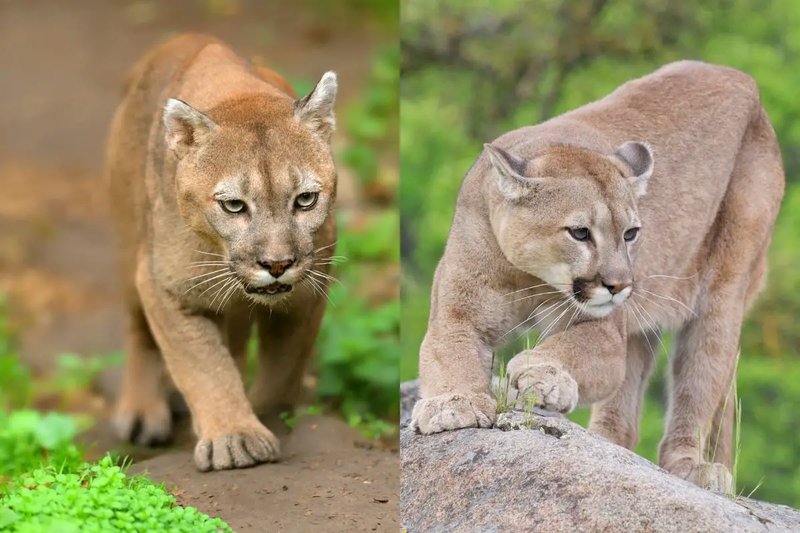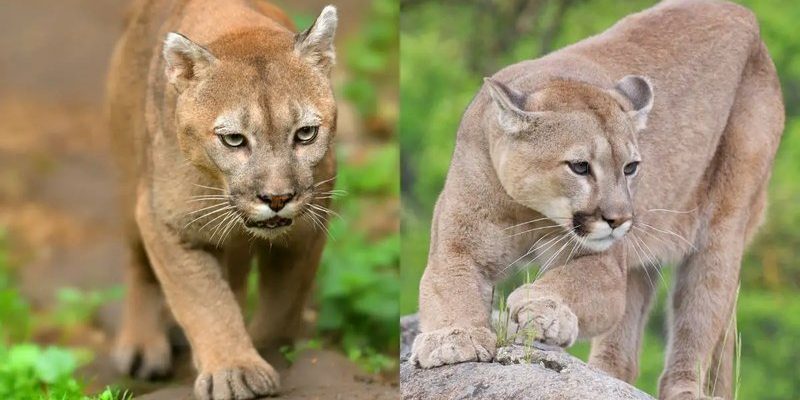
In this look at “10 Animals Similar to the Cougar and How to Tell Them Apart,” we’ll dive into the feline family and beyond. Think of it as a fun nature trivia session, where we explore these unique creatures and their quirks. Grab a cup of coffee, get comfy, and let’s figure out how to distinguish these animals from our beloved cougars!
1. Bobcat
Bobcats are often seen as the little cousins of cougars. These medium-sized wildcats have a similar build but are much smaller, weighing between 15 to 35 pounds. Their distinctive feature? Those short tails! That’s where their name comes from—”bobbed” tail. In terms of coloring, you’ll find bobcats sporting a beautiful tan or reddish-brown coat, often with dark spots or stripes that help them blend into their natural habitats.
How to tell them apart: The first giveaway is size. While cougars can weigh up to 220 pounds, bobcats are just a fraction of that. Plus, bobcats have tufted ears and a shorter face, giving them a noticeably different appearance. If you spot a feline with a bobbed tail and a smaller frame in wooded areas, chances are it’s a bobcat, not a cougar.
2. Lynx
Lynx are another member of the wildcat family that resembles cougars but comes with its own distinctive flair. There are different species of lynx, like the Canadian Lynx and the Eurasian Lynx. What stands out the most about them? Those giant tufts of fur on their ears and their long legs, which are perfectly adapted for moving through snowy terrain.
How to tell them apart: Lynx are typically smaller than cougars, weighing around 18 to 66 pounds. They also have larger, rounder feet that act like snowshoes, allowing them to traverse snowy landscapes easily. If you’re seeing a wildcat with long limbs and tufted ears, you might just be looking at a lynx rather than a cougar.
3. Jaguar
Moving from the small cats to the big ones—enter the jaguar! These powerful predators are larger and stockier than cougars, often found in rainforests, swamps, and grasslands in Central and South America. Jaguars are known for their unique rosette markings, which are similar but larger and more densely packed compared to those of a leopard.
How to tell them apart: Jaguars are typically heavier, weighing between 100 to 250 pounds. They also have a more robust build and shorter legs compared to cougars. If you’re in the jungles of South America and see a big cat with a strong jaw and distinctive markings, it’s likely a jaguar, not a cougar.
4. Leopard
Leopards might be one of the most recognizable big cats, thanks to their spotted coats and adaptability to various habitats across Africa and Asia. Like jaguars, they have rosettes, but these are smaller and more spaced out. Leopards are known for their climbing skills, often dragging their prey into trees to keep them safe from scavengers.
How to tell them apart: While cougars and leopards can look similar at first glance, leopards are generally smaller, weighing around 66 to 176 pounds. They also have a more robust, stocky body and are often found in different regions than cougars. If you spot a spotted kitty lounging in a tree, it’s likely a leopard, not a cougar.
5. Cheetah
Cheetahs are the sprinters of the animal kingdom, famous for their incredible speed—up to 75 miles per hour! Their slender bodies and long legs set them apart from cougars, as does their unique black tear stripes that run from their eyes down to their mouths.
How to tell them apart: Cheetahs have a much lighter build than cougars, weighing around 77 to 143 pounds. Their smaller heads and long, thin bodies make them easily distinguishable. If you’re watching a cat sprint like a rocket across the savanna, it’s definitely a cheetah and not a cougar!
6. Caracal
Caracals are somewhat of a hidden gem in the wildcat family. They have striking tufted ears and a strong, athletic build. These medium-sized cats are found in Africa and parts of the Middle East and are known for their extraordinary jumping abilities—often seen leaping high into the air to catch birds.
How to tell them apart: Caracals are smaller than cougars, usually weighing around 20 to 50 pounds. Their fur is a reddish-tan color, and they have distinct ear tufts, which cougars lack. If you see a cat with a proud stance and remarkable agility, it might just be a caracal.
7. Ocelot
Ocelots are small wildcats native to the Americas, with a beautiful coat featuring a mix of stripes and spots. These cats are more about stealth in dense vegetation than the muscular build of cougars. They’re generally about the size of a domestic cat but can weigh between 20 to 40 pounds.
How to tell them apart: Ocelots are much smaller than cougars and have a more delicate, slender appearance. Their unique spot patterns and smaller size make them quite different. If you find a small cat with striking markings in the underbrush, it’s likely an ocelot.
8. Serval
Serval cats are known for their long legs and large ears, which help them locate prey in tall grasslands. They can jump impressive distances, hunting birds and small mammals with ease. Their coat is typically golden-yellow with black spots and stripes, reminiscent of a cheetah but far smaller.
How to tell them apart: Servals weigh between 20 to 40 pounds, making them smaller and more slender compared to cougars. Their elongated limbs and large ears give them a unique look. If you spot a cat that looks like it’s built for jumping, you’re likely looking at a serval rather than a cougar.
9. African Wildcat
The African wildcat is often called the ancestor of our domestic cats. They have a more slender and long-bodied frame, typically weighing between 8 to 16 pounds. Their coat is usually a reddish-tan color, with faint stripes, and they thrive in arid environments.
How to tell them apart: African wildcats are much smaller than cougars and have a less muscular build. Their face is also narrower, giving them a different appearance. If you encounter a small, wild-looking cat in the savanna, it’s likely an African wildcat, not a cougar.
10. Domestic Cat
You might not think of a domestic cat in the same breath as cougars, but they actually share a lot of similarities—especially in behavior. They share common ancestors and exhibit similar hunting instincts and social behaviors.
How to tell them apart: Domestic cats are obviously much smaller than cougars, typically weighing between 5 to 20 pounds. They also have varying colors and patterns, plus their behavior tends to be more social and less solitary. If you’re petting a fluffy furball on your couch, you’re definitely not looking at a cougar!
Knowing the difference between cougars and these other ten fascinating animals can be a fun trivia tidbit to share at your next gathering or a great way to appreciate wildlife. Each of these creatures has its own unique adaptations and characteristics that make them special.
Whether you’re hiking in the mountains, watching wildlife documentaries, or just enjoying a stroll in nature, remember to take a moment to appreciate the beauty and diversity of the animal kingdom. And who knows? You might even spot a few bobcats or ocelots on your adventures. Nature has a way of surprising us, and understanding how to tell these animals apart only adds to the excitement!

